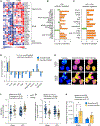Maternal diet alters long-term innate immune cell memory in fetal and juvenile hematopoietic stem and progenitor cells in nonhuman primate offspring
- PMID: 37058409
- PMCID: PMC10570400
- DOI: 10.1016/j.celrep.2023.112393
Maternal diet alters long-term innate immune cell memory in fetal and juvenile hematopoietic stem and progenitor cells in nonhuman primate offspring
Abstract
Maternal overnutrition increases inflammatory and metabolic disease risk in postnatal offspring. This constitutes a major public health concern due to increasing prevalence of these diseases, yet mechanisms remain unclear. Here, using nonhuman primate models, we show that maternal Western-style diet (mWSD) exposure is associated with persistent pro-inflammatory phenotypes at the transcriptional, metabolic, and functional levels in bone marrow-derived macrophages (BMDMs) from 3-year-old juvenile offspring and in hematopoietic stem and progenitor cells (HSPCs) from fetal and juvenile bone marrow and fetal liver. mWSD exposure is also associated with increased oleic acid in fetal and juvenile bone marrow and fetal liver. Assay for transposase-accessible chromatin with sequencing (ATAC-seq) profiling of HSPCs and BMDMs from mWSD-exposed juveniles supports a model in which HSPCs transmit pro-inflammatory memory to myeloid cells beginning in utero. These findings show that maternal diet alters long-term immune cell developmental programming in HSPCs with proposed consequences for chronic diseases featuring altered immune/inflammatory activation across the lifespan.
Keywords: CP: Immunology; DoHaD; Western-style diet; epigenetics; fatty acid; glycolysis; hematopoiesis; inflammation; macrophage; obesity.
Copyright © 2023 The Authors. Published by Elsevier Inc. All rights reserved.
Conflict of interest statement
Declaration of interests The authors declare no competing interests.
Figures







References
Publication types
MeSH terms
Grants and funding
- P51 OD011092/OD/NIH HHS/United States
- P30 DK048520/DK/NIDDK NIH HHS/United States
- P30 NS048154/NS/NINDS NIH HHS/United States
- R01 DK119394/DK/NIDDK NIH HHS/United States
- R01 DK108910/DK/NIDDK NIH HHS/United States
- F30 DK122672/DK/NIDDK NIH HHS/United States
- R24 DK090964/DK/NIDDK NIH HHS/United States
- P50 HD071836/HD/NICHD NIH HHS/United States
- R01 DK128416/DK/NIDDK NIH HHS/United States
- R01 DK128187/DK/NIDDK NIH HHS/United States
- P30 DK116073/DK/NIDDK NIH HHS/United States
- P30 CA225520/CA/NCI NIH HHS/United States
LinkOut - more resources
Full Text Sources
Medical
Miscellaneous

